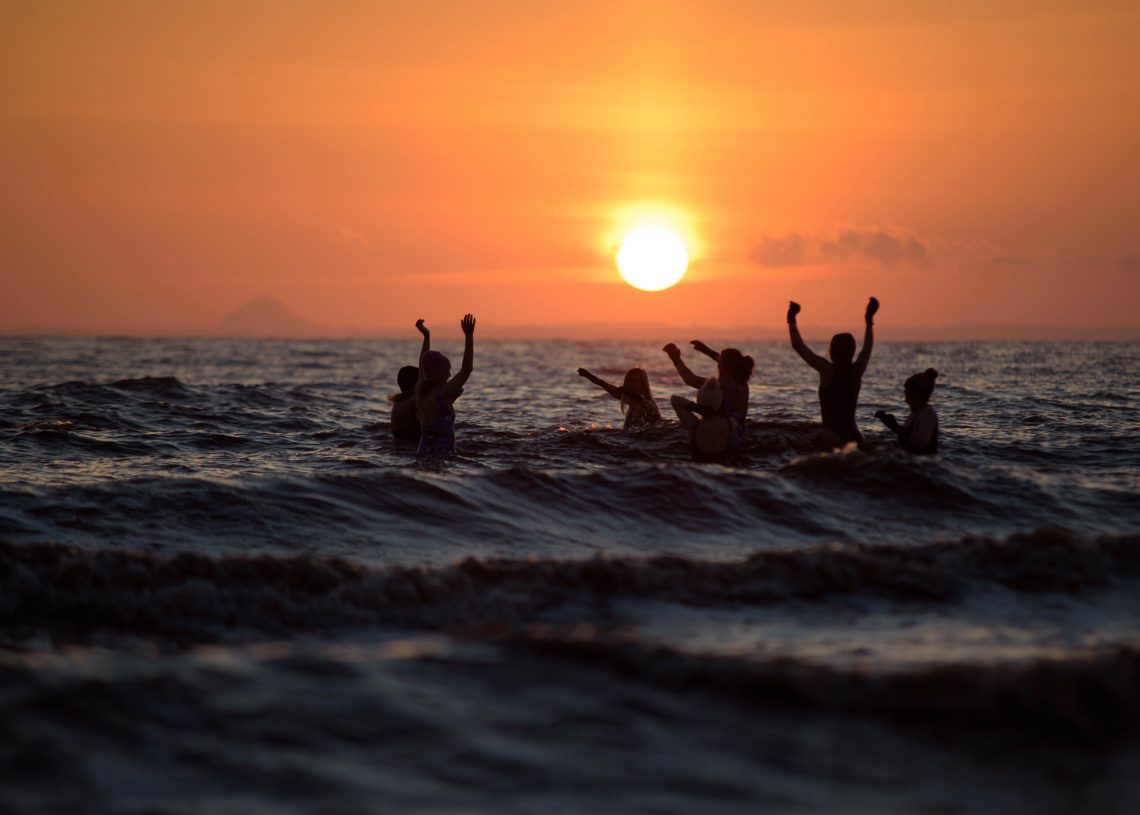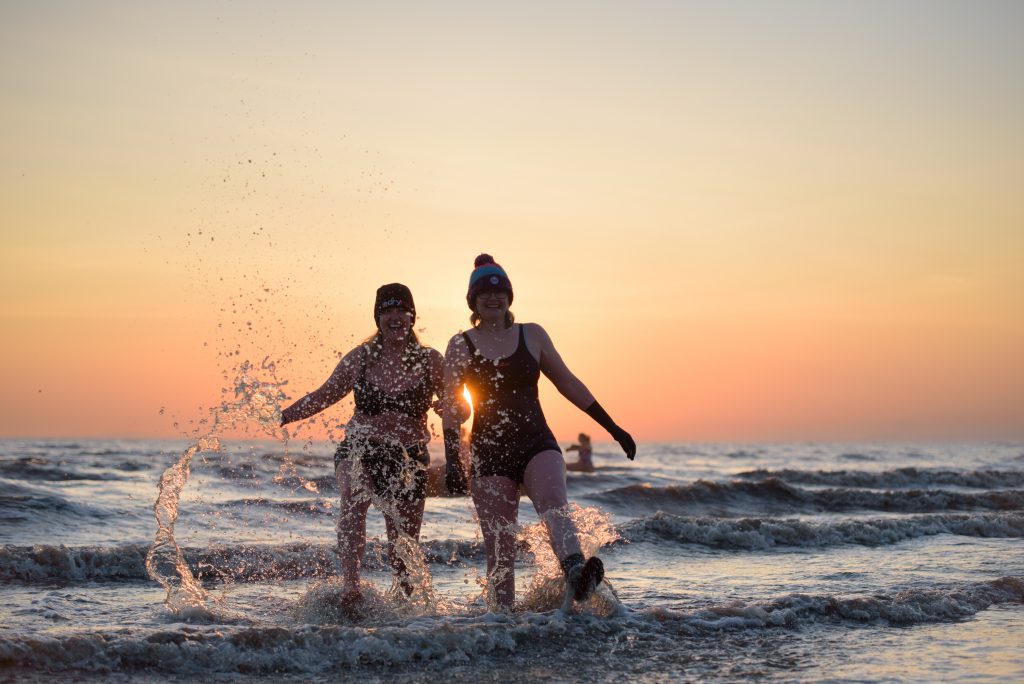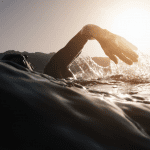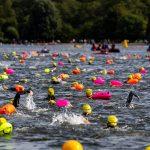
The Ripple Effect
This month, authors Anna Deacon and Vicky Allan return with a new book, The Ripple Effect: A Celebration of Britain’s Brilliant Wild Swimming Communities, exploring how swimming communities have grown in recent years. Here they introduce an extract from the book.
It starts with a ripple. Everything does. A ripple, a disturbance, the beat of a butterfly’s wing.
Back in 2018, when what we call ‘the originals’ gathered on our local Wardie Bay beach, there would generally be no more than ten hardy folk, often laughed at by others, who would shake their heads and declare, “You’d never catch me doing that.”
Four years later, in the run-up to Christmas 2022, there were hundreds – all pitched up for a charity swim in aid of the local hospice. The bakes were selling like hot cakes, a queue trailed halfway down the beach to buy raffle tickets and a herd of ecstatic figures, dressed in Santa hats and baubles, thundered and squealed into the water.
It seems grandiose to talk about the wild swimming movement – isn’t a movement normally a matter of rights? – but the word fits with what we see out there. A ripple, a wave, a movement.
When, in 2019, we published our first swimming book, Taking the Plunge, we joked that we were lucky to have caught the peak of what seemed like a small wild swimming wave. Then Covid hit, and the wave swelled. We looked around and there were more groups, more Bluetits, Blue Balls, Menopausal Mermaids, Polar Bears, Selkies, Salty Sisters, Blue Flamingos, Salty Seabirds, Salty Grief Warriors, Bob & Blether, Out of Sink Synchro Swimmers. There were names that made us chuckle – names that said something about the daft and playful wild swimming world we knew.



So, yes, let’s call it a movement. And let’s also call that movement joy. Because – when we look at what all the different groups have in common – that’s what we see. It’s joy laced with a bit of inner child.
What’s striking, too, is that wild swimming doesn’t exist in isolation. In these group names, we can see many other movements expressed. Each chapter of our book tells one of their stories. Menopause awareness, mental health, body positivity, sobriety, male mental health. There are even, in our Dawnstalkers chapter, ripples of climate awareness and eco-anxiety.
“Is it the swimming, or is it the community?”
We also began to see, as we looked at our groups, how many of swimming’s benefits weren’t strictly the physiological effects that have now been much researched. It’s not all about diving into the cold – it’s about doing it together, in company, and supporting each other all the way through.
That’s why, early on in writing the book, we asked one of our heroes, Dr Rangan Chatterjee, the big question: “Is it the swimming, or is it the community?” “It’s a bit of both,” he said, “but I think the community is probably the biggest thing.” Rangan recalled how Nick Pearson, the CEO of Parkrun, once told him, “Parkrun is a social intervention masquerading as a running event.” That idea, he said, had stayed with him – that there was something important in socially coming together to exercise. “I think,” he said, “community is the missing piece in health.”
In the book you will find many people reflecting on that question and pondering what it is about swimming together that can be so transformational – as well as those who simply celebrate and describe what it is and what it feels like. It starts with one beach – the city bay on which Anna first began swimming, before there was anything like a community frequenting it, when there was only the faintest ripple of wild swimming on its shore.
This beach was our jumping board, our platform from which to dive off, as we started to explore the patchwork of communities at our shorelines. For it seemed to us that this tiny city beach contained all the pieces, all those different movements, in a microcosm. In this one small bay we found so many types of groups, all using the same stretch of sand. There were skinny dippers, ice warriors, mental health swimmers and moon worshippers. There were fundraisers and coaches. All of wild swimming life seemed to be there.
The Wardie Bay Wild Ones: Anna’s Story
I moved to Edinburgh in 2016 and our new home was only a five-minute walk from the sea. When we explored the area, we discovered a little harbour with a beach next to it. Most days I went walking there. It is great for sea glass, seabirds and seals, and not regularly cleaned or cared for by the local authority, which meant alongside the nature there was often a lot of seaborne litter.
However, aside from the odd dog walker, I rarely saw anyone there. Hidden from the road which runs alongside it, the beach is sheltered by a long breakwater and grows and shrinks enormously with the tide. The views across the Firth of Forth to Fife are punctuated by a little island halfway across. This became my patch; I litter picked, I ran, I beachcombed, and I started to consider swimming although, as I had never seen anyone swimming there, I was too nervous to attempt it as it was such an unknown quantity.
A little later, I joined a swimming group called the Wild Ones who met at a much larger beach, Portobello, further east along the coast, after seeing some intrepid swimmers exit the water on a freezing cold day onto frozen sand. I knew I wanted to do that too.
It reminded me of hilariously cold swims in the Highlands with my sister through my childhood, and teenage skinny dips in frozen lochs and the wondrous rush of adrenaline and joy I felt afterwards. I swam as much as I could with my cousin, who was already a seasoned all-year-round swimmer, but it wasn’t always possible to meet up and I wanted to swim more regularly.

The group seemed very friendly when they chatted on Facebook, but I couldn’t pluck up the courage to actually go and meet them in real life. Then one day someone mentioned Wardie Bay and asked if anyone had swum there. There was a handful of us who replied saying we would love to try, and so we met in late summer 2018 for the first Wardie Bay swim. None of us knew anyone, so we were all in the same boat; there were about eight of us on that first swim and we decided to meet every Sunday at the same time. The Wardie Wild Ones group was born.
Loony dooks and solstice swims
People always stopped and stared incredulously at us, asked us if we were mad, if we were going to freeze in there. But often people would say they have always fancied a sea swim and could they join us. Our group grew slowly but surely, we invited friends along to try it out and, by the end of 2019 we had probably around 50 people in our Facebook group and regular weekend dip times and a few midweek sessions too. We celebrated birthdays on the shore with little beach fires and birthday cakes, we had dressing-up swims at Easter, Christmas and solstices, we had loony dooks on New Year’s Day, night swims, adventured elsewhere as a group to try new places, and we often met up with the Wild Ones group down in Portobello, joining them for social evenings and big swims.
When the Covid pandemic struck, our community, like so many others, was displaced. You couldn’t swim together, so many people started swimming alone, or just not swimming at all. As we were stuck in our local area, more people started to visit the beach. And the beautiful weather at the beginning of lockdown made the prospect of a sea swim so enticing, and so the number of swimmers at our little beach began to grow. As restrictions eased off, small groups formed, new swimmers brought friends along and bit by bit everything changed.
We now have a vibrant community of over three thousand swimmers in our Facebook group, with more joining all the time, and now the beach nearly always has a little pod of swimmers on it. Many smaller groups formed through the pandemic now meet regularly for swims. A big community fundraiser swim at Christmas raised money for the local hospice, St Columba’s; a large gathering took part in a summer solstice yoga session followed by a dip; there are swim teachers giving regular classes to improve your open water strokes; a sunrise skinny dip group; a mental health swimming group… and so much more. Money raised from dip-a-day charity swims and other charity swim events goes to local charities, and regular beach cleans take place as swimmers are keen to look after their patch. All these friendships and connections that spread beyond the water mean that the ripple effect from this small beach out to the local community is really being felt.
And this is just our tiny local beach. A similar ripple is also being felt right across the UK and beyond as wild swimming grows and with it a swell of wellbeing, friendships and, most of all, community. What goes on at the beach is an extension of the local community. There are so many stories I could tell of people I have met and of connections forged through swimming. Here is just one that says so much about the web that exists between the beach and the city.
Spreading warmth through the swimming community
In 2019 my darling granny was receiving end-of-life care in a local care home, which is where I went to show her the very first copy of Taking the Plunge. Granny was a photographer, too, and for me to show her a book of my photographs was a real moment; she was able to hold it and look through it with me and it meant the world to me to share that with her. She sadly died, with us at her side, the day the book was published. I will always remember the amazing staff who cared for her; in particular Angela, who gave my dear granny such care and would always lift her spirits and make her laugh. It was clear that Angela was a very special human being.
I didn’t want to leave Granny on her own after she passed, but Angela gave me a hug and said she would stay with her until the undertakers arrived, so she wasn’t alone. That small act of kindness meant so much to us as a family and we were deeply touched when she attended the funeral, too.
The next time I saw Angela was on the beach around a year or two later, she had a small group of women with her, and we ran to each other for a huge hug. She had read the copy of Taking the Plunge that I’d left in the care home with Granny and had decided to give swimming a go during lockdown. The incredible warmth Angela showed to our family and my granny was right there on the beach. She has inspired so many people to the water and has become something of the mother hen to a group of women that just keeps growing – they are always laughing, always having fun.

The Ripple Effect: A Celebration of Britain’s Brilliant Wild Swimming Communities
Wild swimming isn’t just an activity. It has been a movement, a wave that has surged in popularity across Britain, rippling out and spreading joy. And at the centre of it all are the groups and communities that gather at the water’s edge… to dip together, scream together, laugh together, and share stories and support.
If you buy a product through a link on this page we may receive a commission.
Second image: Orca/Lizzie Churchill








